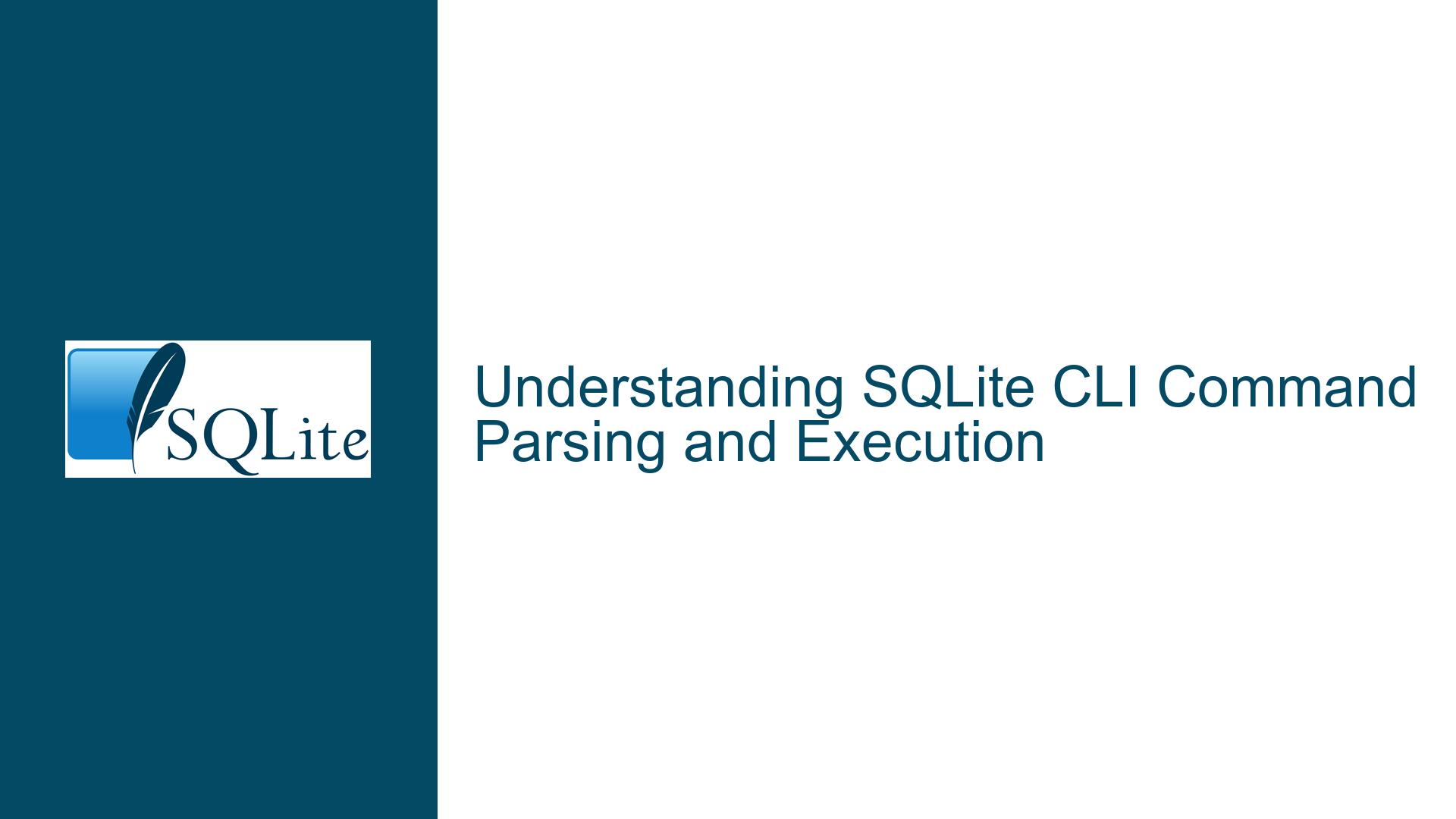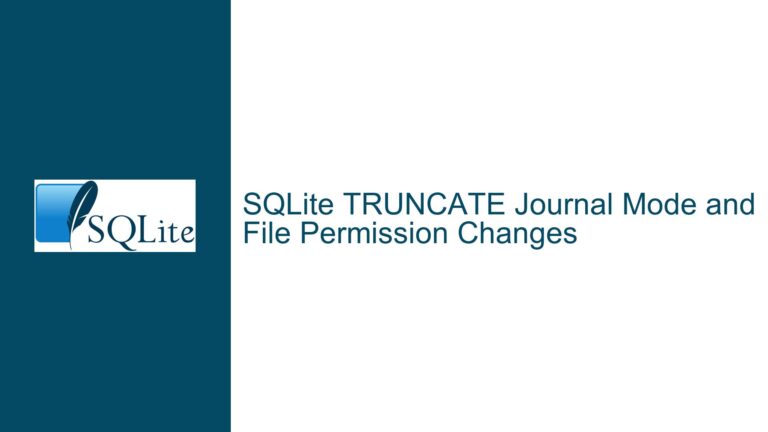SQLite CLI Command Parsing and Execution
Issue Overview: SQLite CLI Command Parsing and Execution
The core issue revolves around the proper usage of the SQLite Command Line Interface (CLI) and the correct parsing and execution of commands, particularly when combining SQL statements with CLI-specific commands. The SQLite CLI is a powerful tool that allows users to interact with SQLite databases directly from the command line. However, its behavior can be nuanced, especially when mixing SQL commands with dot-commands (commands that start with a period, such as .import).
The problem arises when users attempt to execute a sequence of commands that include both SQL statements and CLI-specific dot-commands in a single invocation. The SQLite CLI has specific parsing rules that dictate how these commands are interpreted. For instance, dot-commands must be the first command on a new line, and they are not part of the SQL syntax. This distinction is crucial because it affects how commands are executed and how errors are handled.
In the example provided, the user attempted to execute a compound command that included a DELETE SQL statement followed by a .import dot-command. The CLI rejected this command sequence, resulting in a syntax error. This rejection occurs because the .import command is not an SQL command but a CLI-specific command that must be parsed and executed differently.
Understanding the separation between SQL commands and CLI-specific commands is essential for effectively using the SQLite CLI. SQL commands are processed by the SQLite engine, while CLI-specific commands are handled by the CLI itself. This separation means that CLI-specific commands cannot be embedded within SQL statements or executed in the same context as SQL commands.
Possible Causes: Misunderstanding CLI Command Parsing Rules
The primary cause of the issue is a misunderstanding of how the SQLite CLI parses and executes commands. The CLI has specific rules for interpreting commands, and these rules are not always intuitive, especially for users who are accustomed to working with SQL in other environments.
One of the key parsing rules is that dot-commands must be the first command on a new line. This rule is in place because dot-commands are not part of the SQL syntax and are instead interpreted by the CLI itself. When a dot-command is encountered, the CLI intercepts it and processes it according to its own rules, which are separate from the SQL parsing rules.
In the example provided, the user attempted to execute a compound command that included both an SQL statement and a dot-command on the same line. This approach violates the CLI’s parsing rules, leading to a syntax error. The CLI expects dot-commands to be on their own line, and when it encounters a dot-command in the middle of an SQL statement, it cannot correctly parse the command sequence.
Another potential cause of confusion is the distinction between SQL commands and CLI-specific commands. SQL commands are processed by the SQLite engine, while CLI-specific commands are handled by the CLI. This separation means that CLI-specific commands cannot be embedded within SQL statements or executed in the same context as SQL commands. Users who are not aware of this distinction may attempt to mix SQL and CLI-specific commands in ways that are not supported by the CLI.
Additionally, the SQLite CLI documentation does not explicitly state that dot-commands must be on their own line, which can lead to confusion for users who are trying to use the CLI for the first time. While the documentation does provide examples of how to use dot-commands, it does not clearly explain the parsing rules that govern their use.
Troubleshooting Steps, Solutions & Fixes: Correctly Using SQLite CLI Commands
To resolve the issue and correctly use the SQLite CLI, users must understand and adhere to the CLI’s parsing rules. The following steps outline how to properly execute SQL commands and CLI-specific commands in the SQLite CLI.
Step 1: Separate SQL Commands and CLI-Specific Commands
The first step is to ensure that SQL commands and CLI-specific commands are executed separately. CLI-specific commands, such as .import, must be on their own line and cannot be embedded within SQL statements. This separation is necessary because the CLI processes dot-commands differently from SQL commands.
For example, instead of attempting to execute a compound command like this:
DELETE FROM artists; .import --skip 1 artists.csv artists
Users should execute the commands separately, like this:
DELETE FROM artists;
.import --skip 1 artists.csv artists
This approach ensures that the CLI correctly parses and executes each command according to its rules.
Step 2: Use Command-Line Arguments for Multiple Commands
Another approach is to use command-line arguments to pass multiple commands to the SQLite CLI. The SQLite CLI allows users to specify multiple commands as arguments after the database filename. This feature can be used to execute a sequence of SQL commands and CLI-specific commands in a single invocation.
For example, the following command sequence can be executed using command-line arguments:
sqlite3 -bail yourdb.sqlite "DELETE FROM artists" ".import --skip 1 artists.csv artists" "SELECT * FROM artists LIMIT 5"
In this example, the DELETE SQL command, the .import CLI-specific command, and the SELECT SQL command are all passed as separate arguments to the SQLite CLI. The CLI will execute each command in sequence, ensuring that the dot-command is correctly parsed and executed.
Step 3: Use Shell Scripts or HEREDOC for Complex Command Sequences
For more complex command sequences, users can use shell scripts or HEREDOC to pass multiple commands to the SQLite CLI. This approach allows users to write a sequence of commands in a script file and then pass the script file to the CLI for execution.
For example, the following shell script can be used to execute a sequence of commands:
#!/bin/bash
sqlite3 -bail yourdb.sqlite <<EOSQL
DELETE FROM artists;
.import --skip 1 artists.csv artists
SELECT * FROM artists LIMIT 5;
EOSQL
In this example, the DELETE SQL command, the .import CLI-specific command, and the SELECT SQL command are all included in a HEREDOC block. The HEREDOC block is passed to the SQLite CLI, which executes each command in sequence.
Step 4: Ensure Proper File Paths and CSV Formatting
When using the .import command to import data from a CSV file, users must ensure that the file paths are correctly specified and that the CSV file is properly formatted. The .import command requires the full path to the CSV file, and the file must be formatted correctly to match the structure of the target table.
For example, if the artists table has three columns (id, name, and genre), the CSV file must have three columns that correspond to these fields. Additionally, the CSV file should not contain any blank lines, as this can cause issues during the import process.
Step 5: Use Shell Arrays for Flexible Command Sequences
For users who need more flexibility in constructing command sequences, shell arrays can be used to store and execute multiple commands. This approach allows users to dynamically construct command sequences and pass them to the SQLite CLI.
For example, the following shell script uses a shell array to store and execute multiple commands:
#!/bin/bash
cmds=(
"DELETE FROM $TABLE"
".import --skip 1 $FILE $TABLE"
)
stdbuf -o0 sqlite3 -csv -header "$DB" "${cmds[@]}"; returncode=$?
In this example, the cmds array stores the DELETE SQL command and the .import CLI-specific command. The array is then passed to the SQLite CLI, which executes each command in sequence.
Step 6: Consult the SQLite CLI Documentation
Finally, users should consult the SQLite CLI documentation for detailed information on how to use the CLI and its various commands. The documentation provides examples and explanations of how to use the CLI, including how to execute SQL commands and CLI-specific commands.
The documentation also includes information on advanced features, such as command-line arguments, shell scripts, and HEREDOC blocks. By consulting the documentation, users can gain a deeper understanding of the CLI’s capabilities and how to use them effectively.
Conclusion
The SQLite CLI is a powerful tool for interacting with SQLite databases, but it requires a clear understanding of its parsing rules and command execution behavior. By separating SQL commands and CLI-specific commands, using command-line arguments, and leveraging shell scripts or HEREDOC blocks, users can effectively use the CLI to execute complex command sequences. Additionally, ensuring proper file paths and CSV formatting, using shell arrays for flexibility, and consulting the SQLite CLI documentation can help users avoid common pitfalls and achieve their desired outcomes.






